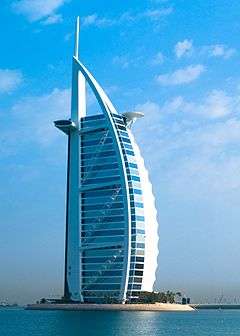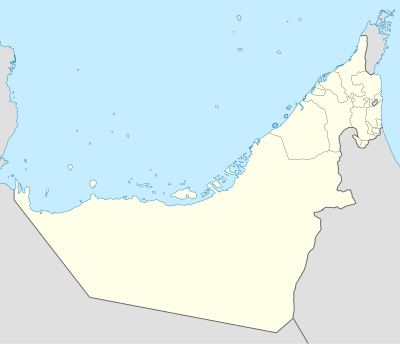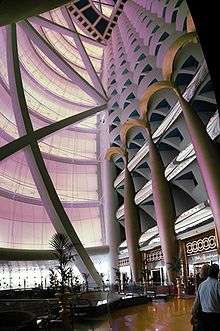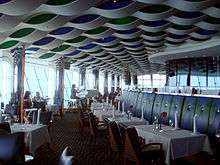Burj Al Arab
The Burj Al Arab (Arabic: برج العرب, Tower of the Arabs) is a luxurious 5 star hotel located in the city of Dubai, United Arab Emirates.[7] One of the tallest hotels in the world, it is the seventh tallest, although 39% of its total height is made up of non-occupiable space.[8][9][10] Burj Al Arab stands on an artificial island 280 m (920 ft) from Jumeirah Beach and is connected to the mainland by a private curving bridge. The shape of the structure is designed to resemble the sail of a ship. It has a helipad near the roof at a height of 210 m (689 ft) above ground.
| Burj Al Arab برج العرب | |
|---|---|
 Burj Al Arab in 2007 | |
 Burj Al Arab Location within United Arab Emirates | |
| General information | |
| Status | Complete |
| Type | Luxury hotel |
| Architectural style | Structural expressionism |
| Location | Dubai, United Arab Emirates |
| Coordinates | 25.141975°N 55.186147°E |
| Construction started | 1994 |
| Completed | 1999 |
| Opening | December 1999 |
| Cost | US$2 billion[1] |
| Height | |
| Architectural | 321 m (1,053 ft) |
| Top floor | 197.5 m (648 ft) |
| Technical details | |
| Floor count | 56 (3 below ground)[2] |
| Lifts/elevators | 18[2] |
| Design and construction | |
| Architect | Tom Wright of WKK Architects |
| Developer | Jumeirah |
| Structural engineer | Atkins |
| Main contractor | Murray & Roberts / Concor |
| Other information | |
| Number of rooms | 202[2] |
| Website | |
| burj-al-arab.com | |
| References | |
| [2][3][4][5][6] | |
Site
The beachfront area where Burj Al Arab and Jumeirah Beach Hotel are located was previously called Miami Beach.[11] The hotel is located on an island of reclaimed land 280 meters offshore of the beach of the former Chicago Beach Hotel.[12] The locale's name had its origins in the Chicago Bridge & Iron Company which at one time welded giant floating oil storage tanks, known locally as Kazzans on the site.[11]
Design and construction
The Burj Al Arab was designed by multidisciplinary consultancy Atkins led by architect Tom Wright, the conceptual design of the building was originally from Uruguayan architect Carlos Ott. It is very similar to the Vasco da Gama Tower located in Lisbon, Portugal. The design and construction were managed by Canadian engineer Rick Gregory also of WS Atkins. Construction of the island began in 1994 and involved up to 2,000 construction workers during peak construction. It was built to resemble the billowing spinnaker sail of a J-class yacht.[13] Two "wings" spread in a V to form a vast "mast", while the space between them is enclosed in a massive atrium.
The hotel was built by South African construction contractor Murray & Roberts / now renamed Concor and Al Habtoor Engineering and the interior works were delivered by UAE based Depa.[14]
The building opened in December 1999.[15]
The hotel's helipad was designed by Irish architect Rebecca Gernon.[16]
Features

Several features of the hotel required complex engineering feats to achieve. The hotel rests on an artificial island constructed 280 m (920 ft) offshore. To secure a foundation, the builders drove 230 forty-meter-long (130 ft) concrete piles into the sand.[17]
Engineers created a ground/surface layer of large rocks, which is circled with a concrete honeycomb pattern, which serves to protect the foundation from erosion. It took three years to reclaim the land from the sea, while it took fewer than three years to construct the building itself. The building contains over 70,000 m3 (92,000 cu yd) of concrete and 9,000 tons of steel.[17]
Inside the building, the atrium is 180 m (590 ft) tall.[18] The 18 storied atrium is enclosed by 12 individually tensioned two-layer membrane panels form the north facing façade.[19]
Given the height of the building, the Burj Al Arab is the world's fifth tallest hotel after Gevora Hotel, JW Marriott Marquis Dubai, Four Seasons Place Kuala Lumpur and Rose and Rayhaan by Rotana. But where buildings with mixed use were stripped off the list, the Burj Al Arab would be the world's third tallest hotel. The structure of the Rose Rayhaan, also in Dubai, is 12 m (40 ft) taller than the Burj Al Arab.
Rooms and suites
The hotel is managed by the Jumeirah Group. Despite its size, the Burj Al Arab holds only 28 double-story floors which accommodate 202 bedroom suites. The smallest suite occupies an area of 169 m2 (1,820 sq ft), the largest covers 780 m2 (8,400 sq ft).[20]
Suites feature design details that juxtapose east and west. White columns show great influence. Bathrooms are accented by mosaic tile patterns.
The Royal Suite, billed at US$24,000 per night, is listed at number 12 on World's 15 most expensive hotel suites compiled by CNN Go in 2012.[21]
The Burj Al Arab is very popular with the Chinese market, which made up 25 percent of all bookings at the hotel in 2011 and 2012.[22]
Services
Experience luxurious shuttle service of the hotel by Rolls Royce or helicopter; private beach...
Restaurants

Al Muntaha ("The Ultimate"), is located 200 m (660 ft) above the Persian Gulf, offering a view of Dubai. It is supported by a full cantilever that extends 27 m (89 ft) from either side of the mast, and is accessed by a panoramic elevator.
Al Mahara ("Oyster"), which is accessed via a simulated submarine voyage, features a large seawater aquarium, holding roughly 990,000 L (260,000 US gal) of water. The wall of the tank, made of acrylic glass in order to withstand the water pressure, is about 18 cm (7.1 in) thick.
Rating
The Burj Al Arab is a seven-star hotel, the highest unofficial official ranking - The term "seven-star" appeared due to a British journalist who had visited the hotel on a tour before the hotel was officially opened. The journalist described Burj al Arab in her article as "a great hotel and more than anything she has ever seen and called it a seven star hotel." While the hotel is sometimes erroneously described as "only a five-star hotel", the hotel management claims never to have done that themselves. In the words of a Jumeirah Group spokesperson: "There's not a lot we can do to stop it. We're not encouraging the use of the term. We've never used it in our advertising."[23]
Reception
Reviews by architecture critics
Burj Al Arab has attracted criticism as well "a contradiction of sorts, considering how well-designed and impressive the construction ultimately proves to be."[20] The contradiction here seems to be related to the hotel's decor. "This extraordinary investment in state-of-the-art construction technology stretches the limits of the ambitious urban imagination in an exercise that is largely due to the power of excessive wealth." Another critic includes negative critiques for the city of Dubai as well: "both the hotel and the city, after all, are monuments to the triumph of money over practicality. Both elevate style over substance."[20] Yet another: "Emulating the quality of palatial interiors, in an expression of wealth for the mainstream, a theater of opulence is created in Burj Al Arab … The result is a baroque effect".[20]
Notable events
Several events have taken place on the helipad 210 m (689 ft) above ground to attract media attention. These include:
- 2004: Tiger Woods teeing off[24]
- 2005: Andre Agassi and Roger Federer playing tennis[25]
- 2006: Ronan Keating shot the Music Video for his single "Iris" at the Helipad of Burj Al Arab.
- 2007: The Today Show broadcast from the Helipad a segment of Where in the World is Matt Lauer?[26]
- 2011: Golfer Rory McIlroy performing a bunker shot.[27]
- 2013: Heli-lift of Aston Martin Vanquish.[28]
- 2013: David Coulthard performing donuts in a Formula 1 racecar.[29]
- 2017: Nick Jacobsen kiteboards down to the sea.[30][31]
In popular culture
The last chapter of the espionage novel Performance Anomalies[32][33] takes place at the top of the Burj Al Arab,[34] where the spy protagonist Cono 7Q discovers that through deadly betrayal his spy nemesis Katerina has maneuvered herself into the top echelon of the government of Kazakhstan. The Hotel can also be seen in Syriana, Mission: Impossible – Ghost Protocol and also some Bollywood movies.
Richard Hammond included the building in his television series, Richard Hammond's Engineering Connections.
The Burj Al Arab serves as the cover image for the 2009 album Ocean Eyes by Owl City.
The Burj Al Arab was the site of the last task of the fifth episode of the first season of the Chinese edition of The Amazing Race, where teams had to clean up a room to the hotel's standards.[35][36]
See also
- W Barcelona (Hotel Vela) – skyscraper of similar appearance in Barcelona, Spain (sail)
- Elite Plaza – a similar-shaped skyscraper in Yerevan, Armenia
- JW Marriott Panama (Panama City) – similar structure
- Spinnaker Tower, Portsmouth – similar structure in Portsmouth, UK
- Vasco da Gama Tower – a skyscraper of similar appearance in Lisbon, Portugal (sail)
- List of tallest buildings in the United Arab Emirates
- List of buildings in Dubai
- List of tallest buildings in Dubai
References
- "Arabian Knight". Forbes.com. Retrieved 24 October 2015.
- "Burj Al Arab Hotel – The Skyscraper Center". Council on Tall Buildings and Urban Habitat.
- Burj Al Arab at Emporis
- "Burj Al Arab". SkyscraperPage.
- Burj Al Arab at Structurae
- "Stay at Burj Al Arab". Jumeirah. Retrieved 4 January 2010.
- Eytan, Declan. "Milan: Inside the World's Only Certified 7 Star Hotel". Forbes. Retrieved 5 April 2018.
- "Vanity Height: the Use-less Space in Today's Tallest". CTBUH. Archived from the original on 17 November 2013. Retrieved 25 November 2013.
- "Study: Skyscrapers Topped by Wasted Space". World Property Channel. 6 September 2013. Retrieved 25 November 2013.
- Solon, Olivia (6 September 2013). "Report names and shames vanity skyscrapers with unnecessary spires". Wired. Archived from the original on 15 November 2013. Retrieved 25 November 2013.
- Krane, Jim City of Gold: Dubai and the Dream of Capitalism, page 103, St. Martin's Press (15 September 2009)
- "Dubai's Chicago Beach Hotel". Dubai As It Used To Be. Retrieved 25 November 2013.
- "Burj Al Arab". www.atkinsglobal.com.
- "Depa announces strong growth". The National.
- "Media Fact File of Burj Al Arab" (PDF). Retrieved 7 August 2018.
- "From the inside out". Construction Week Online Middle East.
- "Burj Al Arab". EgyptEng.com engineering directory. 2000. Archived from the original on 17 January 2007. Retrieved 24 January 2007.
- "VIDEO: Burj Al Arab's 15th anniversary 'dream'". HotelierME.
- "How did Tom Wright use a membranous façade to save The Burj Al Arab from becoming a 321m high oven?". 25 April 2019.
- Damluji, Salma Samar, The Architecture of the U.A.E.. Reading, UK: 2006.
- Arnold, Helen "World's 15 most expensive hotel suites" Archived 2 November 2012 at the Wayback Machine CNN Go. 25 March 2012. Retrieved 11 April 2012
- "Jumeirah gets ravenous for China". TTGmice. Archived from the original on 5 June 2013. Retrieved 27 March 2013.
- "Hotel star ratings standards long overdue". The National. 14 July 2009. Retrieved 10 December 2010.
- "World's number one player Tiger Woods tees off from the world's most luxurious hotel, Burj Al Arab" Hospitality, 9 March 2004. Accessed: 2 November 2013. Photos
- "Agassi, Federer enjoy unique experience" ESPN, 22 February 2005. Accessed: 2 November 2013. Photos Archived 1 November 2013 at the Wayback Machine
- Dubai: Oasis in the desert – Where in the World. TODAY.com (2007). Retrieved on 1 January 2017.
- "Video: Rory McIlroy on the Burj Al Arab Helipad" Jumeirah, 20 December 2011. Accessed: 3 November 2013.
- "Video: Aston Martin – Dubai Centenary Spectacular at Burj Al Arab" Aston Martin, 17 January 2013. Accessed: 3 November 2013.
- "VIDEO: Red Bull in sensational Dubai helipad donut demo" Crash.net, 31 October 2013. Accessed: 2 November 2013. Photos
- "Nick Jacobsen jumps off the Burj al-Arab in Dubai". Surfer Today. 12 April 2017. Retrieved 7 October 2017. Photos
- Nick Jacobsen's Dubai jump on YouTube
- "Performance Anomalies". Goodreads. Retrieved 15 May 2017.
- Lee, Victor Robert (20 December 2012). Performance Anomalies. USA: Perimeter Six. ISBN 9781938409226.
- Lee, Victor Robert (15 January 2013). Performance Anomalies: A Novel. Perimeter Six Press. p. 327. ISBN 978-1-938409-20-2.
- "Burj Al Arab hotel stars in Chinese reality TV show". Arabian Business. 18 November 2014. Retrieved 7 January 2020.
- "卓美亚集团与「极速前进」首次合作" [Jumeirah Group collaborates with The Amazing Race for the first time]. Neeu (in Chinese). Retrieved 7 January 2020.
Further reading
- Rose, Steve. "Sand and Freedom", The Guardian, 28 November 2005, retrieved 27 October 2006.